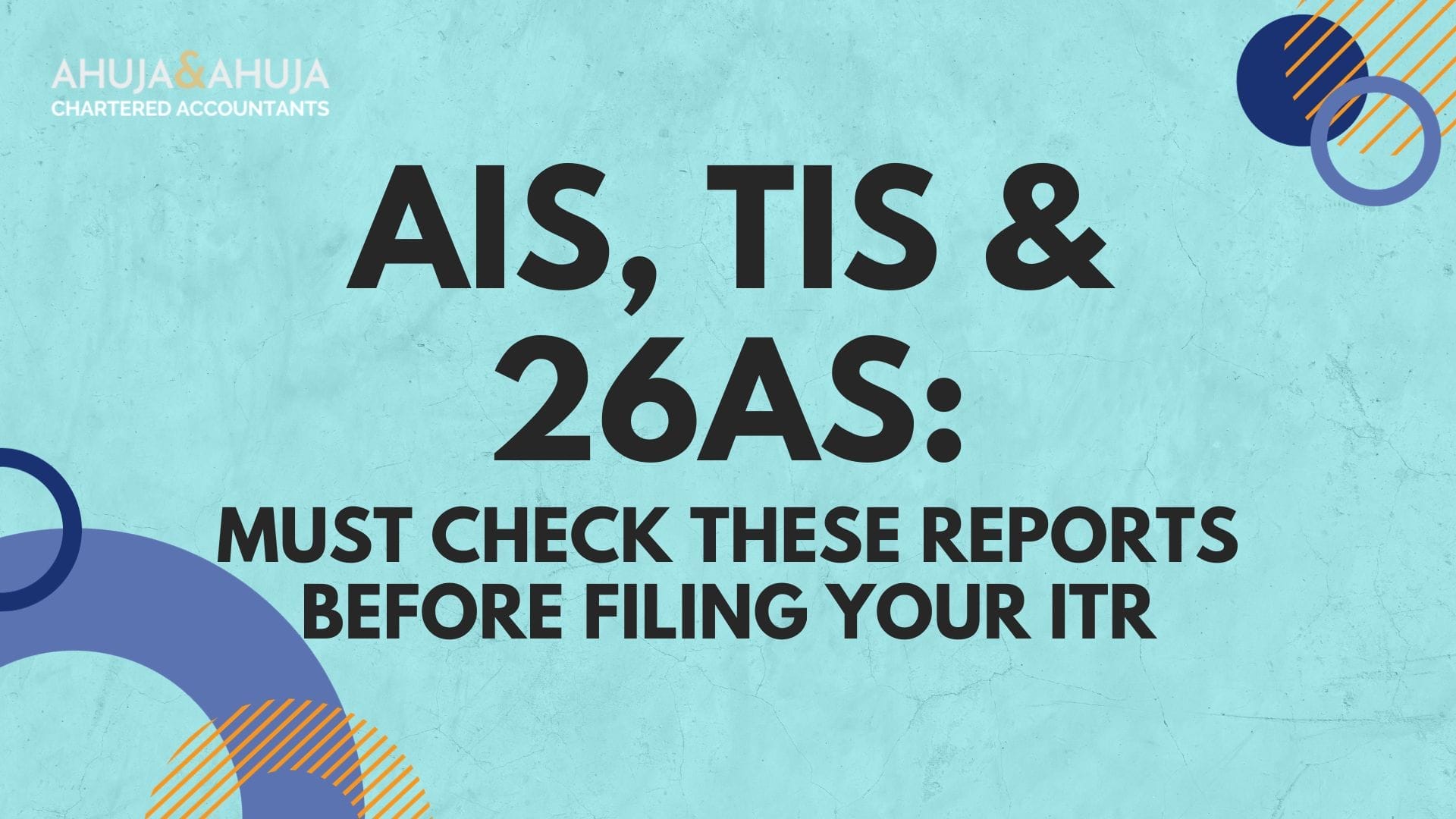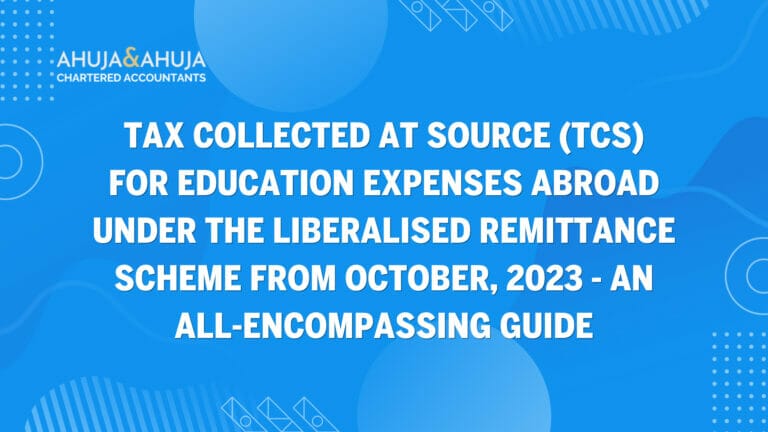AIS, TIS & 26AS: Must Check These Reports Before Filing Your ITR
Understanding AIS, TIS, and Form 26AS and their Relevance in Income Tax Return Filing
Income tax filing is quite an overwhelming process for many. Understanding different income tax documents and their significance is crucial to file a precise and compliant return and avoid any potential lawsuits (Income Tax Litigation). Three central figures reign over the process, namely, the Annual Information System (AIS), Taxpayer Information Summary (TIS), and Form 26AS. In the following sections, they will be explicitly laid open, elucidating how they factor into effective income tax return planning and filing.
Understanding the Annual Information System (AIS)
The Annual Information System (AIS) is a powerful tool launched by the Income Tax Department in India to collect information about an individual taxpayer’s financial transactions. Throughout a financial year, an individual taxpayer incurs income from different sources – be it salary, rental, interest income, etc. The AIS takes on the task of gathering data related to these various income sources, the taxes deducted at source (TDS), taxes paid by the taxpayer, and more such critical tax-relevant information.
To illustrate the AIS’s role better, consider an example of a taxpayer named Mr. X. Mr. X withdraws income from multiple veins, from salary to rental & interest income. As Mr. X avails these income sources, the corresponding entities like the employer, bank, or tenant deduct the required tax at source. On top of this, Mr. X also makes advance tax payments and self-assessment tax payments. All of this invaluable tax-related information is collated and curated by the AIS into a comprehensive document – Form 26AS.
Filing of income tax return might seem a complex procedure, professional guidance available through services like Income Tax Return Filing can make the process a hassle-free experience. Also, a new feature by the income tax department called Faceless Assessment makes the process even more streamlined, reducing physical interactions and promoting transparency and efficiency.
The Functionality of AIS and Understanding the Form 26AS
The Annual Information System (AIS) serves as an essential bridge between taxpayers and the Income Tax Department. It provides taxpayers with a consolidated view of their tax credits, tax liabilities, and other relevant tax-related information. This consolidated view is presented through a document called Form 26AS.
Understanding Form 26AS
Form 26AS is a consolidated tax statement that includes various details related to income tax. It provides a comprehensive view of an individual taxpayer’s financial transactions, including tax deducted at source (TDS), tax collected at source (TCS), advance tax payments, and self-assessment tax payments. Additionally, it also reflects income tax refunds, high-value transactions, and other pertinent information.
Form 26AS acts as a ready reckoner for taxpayers while preparing to file their income tax returns (ITRs). It includes crucial information that taxpayers need to verify, reconcile, and report accurately in their ITRs. By referring to Form 26AS, taxpayers can ensure that their reported income aligns with the information available with the Income Tax Department.
Accessing Form 26AS
The Income Tax Department provides a user-friendly online platform for taxpayers to access their Form 26AS. By logging into their accounts on the Income Tax e-filing portal, taxpayers can conveniently view, download, and cross-reference their Form 26AS. This easy accessibility enables taxpayers to verify the accuracy of the information presented in the form and identify any discrepancies or missing details that need to be addressed before filing their ITRs.
The Role of AIS and Form 26AS in ITR Filing
The Annual Information System (AIS) and Form 26AS play significant roles in the process of filing income tax returns. By accessing the AIS through Form 26AS, taxpayers gain access to a consolidated view of their tax credits and liabilities. This enables them to cross-reference the information provided in Form 26AS with their own records and identify any discrepancies or missing details. Correcting these errors or omissions before filing the ITRs helps taxpayers avoid potential issues with the tax authorities and ensures accurate reporting of income and taxes.
Furthermore, the information available in Form 26AS serves as a valuable resource during tax assessments or audits. It provides a comprehensive record of the taxpayer’s financial activities and tax liabilities, promoting transparency and accountability in the tax system.
Continually monitoring Form 26AS is crucial for taxpayers to stay informed about their tax obligations, verify the accuracy of their tax information, and maintain compliance with tax laws. It allows taxpayers to identify and rectify any discrepancies or missing information promptly, avoiding unnecessary penalties or scrutiny from tax authorities.
Understanding Taxpayer Information Summary (TIS) and its Relevance
In addition to the Annual Information System (AIS) and Form 26AS, taxpayers also need to familiarize themselves with the Taxpayer Information Summary (TIS). The TIS statement provides taxpayers with a summarized overview of their tax-related information, including tax returns filed, taxes paid, refunds received, and other essential details.
Understanding Taxpayer Information Summary (TIS)
The Taxpayer Information Summary (TIS) is a statement that consolidates the tax information available with the Income Tax Department for a specific taxpayer. It serves as a summary of the taxpayer’s tax-related activities and provides valuable insights into their tax compliance.
The TIS statement includes details such as the number of tax returns filed by the taxpayer, taxes paid, refunds received, and any outstanding tax liabilities. It serves as a useful tool for taxpayers to review and reconcile their own tax records with the information maintained by the Income Tax Department.
Accessing TIS
Taxpayers can conveniently access their TIS statement online through the Income Tax Department’s e-filing portal. By logging into their e-filing accounts, taxpayers can view and download their TIS statement as and when required.
Regularly reviewing the TIS statement is crucial for taxpayers to ensure the accuracy of their tax information and identify any discrepancies. It allows taxpayers to cross-verify the information maintained by the Income Tax Department with their own records and take appropriate measures to rectify any errors or inconsistencies.
Relevance of TIS in Income Tax Return Filing
The Taxpayer Information Summary (TIS) plays a vital role in the process of income tax return (ITR) filing. By reviewing the TIS statement, taxpayers can verify the accuracy of their tax-related information and ensure that it aligns with the records maintained by the Income Tax Department.
The TIS statement helps taxpayers reconcile their own tax records with the information available with the Income Tax Department. It provides an opportunity to identify any missing or incorrect information that may need to be addressed before filing the ITR. This proactive approach can help taxpayers avoid penalties and scrutiny from the tax authorities.
Moreover, the TIS statement serves as a reliable source of information during tax assessments or audits. It provides a summarized overview of the taxpayer’s tax compliance and serves as evidence of their tax-related activities. By regularly monitoring the TIS statement, taxpayers can maintain transparency and accountability in their tax affairs.
Importance of AIS and TIS for Taxpayers
The Annual Information System (AIS) and Taxpayer Information Summary (TIS) play significant roles in the tax compliance process for individuals and businesses. These systems provide taxpayers with comprehensive information about their financial transactions, taxes deducted at source, taxes paid, and refunds received. Understanding the importance of AIS and TIS can help taxpayers ensure accurate reporting of their income and taxes, avoid discrepancies, and stay compliant with tax laws.
Comprehensive View of Tax Obligations
By accessing the AIS through Form 26AS, taxpayers gain a consolidated view of their tax liabilities and credits. This allows them to track their income from various sources, monitor taxes deducted at source, and ensure that taxes are paid in a timely manner.
The AIS provides taxpayers with a holistic understanding of their financial activities and serves as a valuable tool for managing their tax obligations. By having access to a comprehensive view of tax-related information, taxpayers can make informed decisions about their tax planning, optimize tax savings, and avoid penalties arising from non-compliance.
Verification and Reconciliation
Regularly reviewing the TIS statement helps taxpayers verify the accuracy of their tax information. By comparing the details in the TIS statement with their own records, taxpayers can identify any discrepancies or missing information that may need to be addressed.
The TIS statement enables taxpayers to reconcile their tax records, ensuring that all relevant income, taxes paid, and refunds received are accurately reported. This verification process helps taxpayers avoid any potential errors or omissions in their income tax returns and minimizes the risk of facing inquiries or audits from the tax authorities.
Transparency and Accountability
Both the AIS and TIS statements provide transparency and accountability in the tax system. By tracking their tax obligations and understanding the impact of deductions and exemptions, taxpayers can ensure proper compliance with tax laws.
The AIS and TIS statements serve as valuable tools during tax assessments or audits. They provide a comprehensive record of the taxpayer’s financial activities and tax liabilities, allowing tax authorities to assess the accuracy and completeness of the information provided in the income tax returns.
Accessing AIS and TIS
Accessing the Annual Information System (AIS) and Taxpayer Information Summary (TIS) is crucial for taxpayers to stay informed about their tax obligations and ensure accuracy in their tax filings. The Income Tax Department provides a user-friendly online platform that enables taxpayers to conveniently access their AIS and TIS statements.
Accessing AIS and TIS Statements
Taxpayers can access their AIS and TIS statements online through the Income Tax Department’s e-filing portal. By logging into their e-filing accounts, taxpayers can view and download their AIS and TIS statements at their convenience.
Regularly checking the AIS and TIS statements allows taxpayers to stay updated on their tax-related activities. It provides an opportunity to verify the accuracy of the information and reconcile it with their own records.
Importance of Regular Monitoring
Regular monitoring of the AIS and TIS statements is essential to ensure that the tax-related information is accurate and up to date. By reviewing these statements, taxpayers can identify any discrepancies, missing information, or errors that may need to be addressed.
Monitoring the AIS and TIS statements helps taxpayers maintain transparency in their tax affairs and ensures compliance with tax laws. It allows them to track their tax obligations, understand the impact of deductions and exemptions, and make necessary adjustments to their tax planning if required.
Conclusion
The Annual Information System (AIS) and Taxpayer Information Summary (TIS) are valuable resources for taxpayers in India. These systems provide a consolidated view of a taxpayer’s financial transactions, taxes deducted at source, taxes paid, and refunds received.
By accessing the AIS through Form 26AS and reviewing the TIS statement, taxpayers can ensure the accuracy of their tax information, reconcile their records, and stay compliant with tax laws. Regular monitoring of AIS and TIS statements is crucial for maintaining transparency, resolving discrepancies, and avoiding potential issues with the tax authorities.
In conclusion, understanding and utilizing the AIS and TIS statements are essential for effective tax planning and accurate income tax return filing. By leveraging these tools, taxpayers can have a comprehensive view of their tax-related information, optimize their tax compliance, and avoid any potential penalties or audits. Regularly checking the AIS and TIS statements allows taxpayers to stay informed, proactive, and in control of their tax affairs.
Remember, seeking professional assistance from tax advisors or using specialized services such as Income Tax Return Filing and Faceless Assessment can further streamline the process and ensure compliance with income tax regulations.
Disclaimer
The materials provided herein are solely for educational and informational purposes. No attorney/professional-client relationship is created when you access or use the site or the materials. The information presented on this site does not constitute legal or professional advice and should not be relied upon for such purposes or used as a substitute for professional or legal advice.






